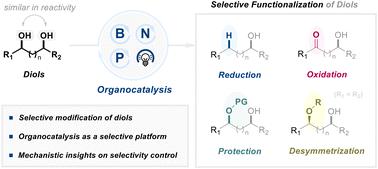有机催化二元醇选择性功能化研究进展
Organic chemistry frontiers : an international journal of organic chemistry
Pub Date : 2025-04-26
DOI:10.1039/d5qo00645g
引用次数: 0
摘要
含有多个羟基的多元醇由于其固有的反应性相似性,对位点选择性功能化提出了持续的挑战。作为最小的多元醇体系,二醇为开发区域选择性催化策略提供了一个实用和概念丰富的平台。本文综述了有机催化二醇功能化的最新进展,综述了含硼、氮和磷基基基的有机催化剂,以及新兴的光氧化还原方法。这些系统能够在温和的条件下进行选择性转化,避免化学计量激活,最大限度地减少反应的复杂性。空间和电子效应,以及非共价相互作用,详细检查合理化观察到的选择性和指导催化剂的合理设计。总的来说,这篇综述为推进二醇衍生化的可持续、选择性方法提供了概念基础。本文章由计算机程序翻译,如有差异,请以英文原文为准。

Recent progress in selective functionalization of diols via organocatalysis
Polyols bearing multiple hydroxyl groups present persistent challenges for site-selective functionalization due to their inherent reactivity similarity. As minimal polyol systems, diols offer a practical and conceptually rich platform for developing regioselective catalytic strategies. This review highlights recent progress in organocatalyzed diol functionalization, with a survey of organocatalysts incorporating boron, nitrogen, and phosphorus-based motifs, as well as emerging photoredox methodologies. These systems enable selective transformation under mild conditions, avoiding stoichiometric activation and minimizing reaction complexity. Steric and electronic effects, along with noncovalent interactions, are examined in detail to rationalize the observed selectivity and guide the rational design of catalysts. This review offers a conceptual foundation for advancing sustainable, selective methods in diol derivatization.
求助全文
通过发布文献求助,成功后即可免费获取论文全文。
去求助
来源期刊
CiteScore
7.80
自引率
0.00%
发文量
0

 求助内容:
求助内容: 应助结果提醒方式:
应助结果提醒方式:


